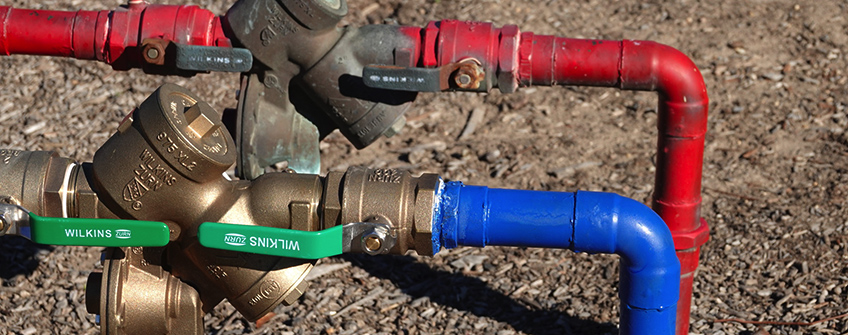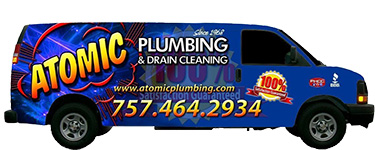Everything You Need to Know About Backflow Preventers
Your washing machine, dishwasher, and toilets are all hooked up to your home’s water supply. As water flows into your home, it is under pressure. This pressure prevents contaminated water from flowing backward into the clean water supply. But what stops the water from your kitchen and bathroom from flowing back into your home’s clean water supply? This is where a backflow preventer comes in. Backflow preventers are required by law in many states and municipalities because they prevent contaminated water from flowing backward into the clean water supply.
What Is Backflow?
Backflow is the unwanted reverse flow of water in a plumbing system. A backflow preventer is a device that maintains water flowing in the proper direction in your house’s plumbing system. Sewage, gray water, or other hazardous pollutants can flow back into fresh water supply pipes, posing a serious health hazard. The points where the potable water system connects with non-potable water appliances and systems are called cross-connections. These connections happen in appliances such as washers, sinks, and toilets, and they must be carefully designed and installed to prevent backflow. The connection of a fire sprinkler system to a water main is another typical location for a backflow preventer, to avoid pressurized water from flowing from the fire suppression system into the public water supply.
How Does Backflow Happen?
Backflow can happen when there is a change in water pressure. This can be caused by a water main break, a power outage, or even something as simple as turning on a garden hose. If the pressure in the water main is lower than the pressure in your home’s plumbing, water can flow backward into your home. This backward flow can contaminate your home’s water supply with bacteria, chemicals, and other pollutants. Backflow can also happen if there is a break in your home’s plumbing system. If water is flowing out of your home through a break in a pipe, the pressure in your home’s plumbing system can drop. This can cause water to flow back into your home, contaminating your water supply.
What Are Backflow Preventers?
Backflow preventers are devices that are installed in your home’s plumbing system. They work to keep contaminated water from flowing backward into the clean water supply. There are several types of backflow preventers to choose from. These include a simple air gap, atmospheric vacuum breakers, pressure vacuum breakers, double-check preventers, and reduced pressure assembly.
Air Gap
The simplest type of backflow preventer is an air gap. An air gap is a physical separation between the water supply and the point where water can enter your home. An air gap is typically used in residential applications. It is the most common type of backflow preventer in use today. A simple air gap is composed of only moving water and no other parts. Various plumbing regulations have a minimum air gap distance required for particular situations, such as a drain connection for your dishwasher. For this reason, it is not ideal for use in all situations.
Atmospheric Vacuum Breakers
These have a shape like that of an elbow, and a valve that stops the backward water flow. They work by allowing air to enter the system, breaking the vacuum, and preventing water from flowing backward. AVBs are not meant to protect against back pressure. Because they rely on air, they are unable to be kept in a compromised atmosphere since polluted air would enter the system and pollute the potable water supply. This means they must be installed 6 inches above the highest water supply in your home. Their simple makeup makes them easy to install and maintain.
Pressure Vacuum Breakers
These are similar to atmospheric vacuum breakers. They work by allowing air to enter the system when water pressure drops, which breaks the vacuum and prevents water from flowing backward. They include a check device or check valve and an open-air venting system. During average circumstances, the check valve is intended to allow water through and keep the air intake shut. When the air pressure is greater than the water pressure, the vented chamber opens and breaks the suction effect of low pressure, preventing backflow. A pressure vacuum breaker is installed close to your water source, typically about a foot above the highest downstream in your plumbing system. The primary disadvantage of pressure vacuum breakers (PVBs) is they too, don’t protect against high back pressure. PVBs are used primarily for back-siphonage rather than back pressure.
Double-Check Preventers
These have two check valves that work together to prevent water from flowing backward. Installation close to your water source isn’t necessary. In fact, you should leave room for maintenance. They are good for use against both back-siphonage and back pressure.
The two check valves are not allowed to be opened at the same time. The first valve is opened when water flows into your home and the second valve is opened when water flows out of your home. This prevents contaminated water from flowing backward into the clean water supply.
Reduced Pressure Assembly
Reduced pressure assembly is the most common and the safest type of backflow preventer available. It has several valves and is one of the most complicated to install and maintain.
They are flexible so you can install them almost anywhere and in any type of pressure situation. They protect against both back pressure and back-siphonage.
Back Pressure vs Back-siphonage
We’ve mentioned these terms a few times above because it’s important to understand the difference between back pressure and back-siphonage. Back pressure is caused when water pressure in the system is greater than the water pressure coming from the main supply. This can happen if there is a break in your home’s plumbing system or if there is a fire and the firefighters are using high-pressure hoses. Back-siphonage occurs when water pressure drops suddenly. This can happen if there is a power outage or if there is a break in the main water supply line.
Back-siphonage is considered indirect cross-contamination, while back pressure is a form of direct cross-contamination.
How to Choose a Backflow Preventer
Now that you know the different types of backflow preventers and how they work, you need to know how to choose the right one for your needs. The first step is to understand which type of cross-contamination you are trying to prevent. If you are only worried about backpressure, then an atmospheric vacuum breaker or a pressure vacuum breaker will suffice. If you are worried about both backpressure and back-siphonage, then you will need a double-check valve or a reduced pressure assembly. The second step is understanding where you need to place the backflow preventer in your plumbing system. Atmospheric vacuum breakers and pressure vacuum breakers must be placed above ground (at least 6 inches for AVBs and 12 inches for PVBs) and before your home’s water supply. This is typically at the end of an outside hose bibb or faucet.
Double-check valves can be placed almost anywhere in your plumbing system if there is enough room for maintenance. Reduced pressure assemblies must be installed after your home’s water meter and before the shut-off valve. The third step is to determine the size you need. Backflow preventers are available in different sizes, depending on the flow rate. The size you need will depend on the type of backflow preventer you choose and where you plan to install it in your plumbing system. Atmospheric vacuum breakers and pressure vacuum breakers are typically available in 1/2-inch, 3/4-inch, and 1-inch sizes. Double-check valves are available in 2-inch, 3-inch, 4-inch, and 6-inch sizes. Reduced pressure assemblies are available in 2-inch to 12-inch sizes. The fourth step is to choose a material. Backflow preventers are made from brass, bronze, cast iron, or stainless steel. The material you choose will depend on the type of backflow preventer you choose and where you plan to install it in your plumbing system.
Atmospheric vacuum breakers and pressure vacuum breakers are typically made from brass or bronze. Double-check valves are available in cast iron or stainless steel. Reduced pressure assemblies are available in brass, bronze, cast iron, or stainless steel. The fifth and final step is to select an approved backflow preventer. You need to make sure the backflow preventer you choose is approved by your local water utility or jurisdiction. Each state and municipality has different requirements so it’s important to check with your local authority before purchasing a backflow preventer. You can find a list of approved backflow preventers on the National Sanitation Foundation’s website.
How Much Do Backflow Preventers Cost?
The cost of a backflow preventer will vary depending on the type of backflow preventer you need and the size of your home’s plumbing system. Atmospheric vacuum breakers usually cost between $50 and $200. Pressure vacuum breakers can cost between $100 and $500. Double-check preventers cost anywhere between $200 and $1,000. Reduced pressure assembly backflow preventers start at a couple of hundred dollars and can climb to tens of thousands depending on your needs.
When Do Backflow Preventers Come in Handy?
Backflow preventers are most often used in homes with private wells or septic systems. They can also be used in homes that are on a public water supply that meets certain requirements. These requirements include if you have a sprinkler system, an irrigation system, or any other type of plumbing system that could potentially contaminate the public water supply. When a fire hydrant is opened for use, or when the major water line breaks, there’s a risk of backflow. During these situations, pressure is lost and water no longer flows forward into your house. Instead, it goes back into the city water mains.
With it goes fertilizers and pesticides, chlorine from your pool, human waste, and the soap from your shower and sinks. This is where a backflow prevention system becomes necessary.
The Benefits of Having a Backflow Preventer for Both Residential and Commercial Properties
Backflow preventers are important for both residential and commercial properties. For residential properties, backflow preventers protect your family from drinking contaminated water. For commercial properties, backflow preventers protect your customers from coming into contact with contaminated water causing liability on your part.
Contaminated water can cause a number of different health hazards, including gastroenteritis, hepatitis, and dysentery. In extreme cases, it can even lead to death. There are many other benefits to having a backflow preventer installed on your property whether commercial or residential. This is especially true if you have an irrigation system.
Some of the benefits of having a backflow preventer include:
- Preventing contamination of the potable water supply
- Protecting your property from costly repairs
- Avoiding lawsuits and liability
- Maintaining the quality of your water supply
Backflow preventers are the best way to protect yourself, your family, and your customers from contaminated water.
How to Know If You Need a Backflow Preventer
If you have a private well or septic system, you should have a backflow preventer. If you have a public water supply, you may still need a backflow preventer depending on the type of plumbing system you have. If you have an irrigation system, sprinkler system, or any other type of plumbing system that could potentially contaminate the public water supply, you will need a backflow preventer. It’s always better to err on the side of caution and install a backflow preventer even if you’re not sure if you need one. The cost of a backflow preventer is much less than the cost of treating contaminated water.
Does an Irrigation System Require a Backflow Preventer?
Irrigation systems require backflow preventers whether they are connected to a private well or septic system or public water supply. This is because there is a risk of contaminated water flowing back into the clean water supply. Contaminants are often introduced into the irrigation system through fertilizers, pesticides, and herbicides. Other contaminants include those that naturally occur in your soil such as bacteria and viruses. They can also include waste we or our pets introduce into our soil such as soap water from washing your car or your dog’s excretions.
These can seep down into your well or private water supply and get into your potable water. If you’re connected to the public system, then it gets not only into your water but that of your neighbors.
What Is Potable Water?
Potable water is any water that you would consider safe to drink. Our water supply comes from non-potable sources such as lakes, rivers, and wells. We treat that water making it safe to drink and pump it through pipes into your home. Therefore it is important for you to have backflow preventers installed in your irrigation system. Once water gets into the pipe it has already passed through the treatment process. It is imperative that no contaminants enter the pipe system as they could harm entire regional areas as it gets distributed through local grids.
Maintenance and Testing Requirements
Most backflow preventers must be installed by a licensed professional. They also require annual maintenance and testing to ensure they are working properly. Most states require that you have your backflow preventer tested by a certified tester. You can find a list of certified testers in your area by contacting your state’s water resources department or searching online.
You will also need to keep up with the maintenance of your backflow preventer. This includes regularly checking the valves and sensors, as well as the pipes and fittings. It is important to catch any problems early so they can be fixed before they cause contamination. If you let a problem go too long it could lead to costly repairs or even replacements.
Consequences of Not Having a Backflow Preventer
If you don’t have a backflow preventer, you could be fined. In some cases, you may even have your water supply shut off. This is because it is a health hazard to yourself and those around you. Not having a backflow preventer is also irresponsible. If there is a contamination incident, it could lead to lawsuits. You could be held liable for any injuries or illnesses that occur as a result of the contaminated water.
Can You Install a Backflow Preventer on Your Own?
Backflow preventers are not typically installed by homeowners. They are installed by licensed plumbers or other qualified professionals. Backflow preventors require a permit and city inspection. Licensed plumbers will have the tools and knowledge necessary to properly install your backflow preventer. The EPA holds local water suppliers liable for ensuring that potable water systems are kept at a certain degree of purity. Backflow prevention assemblies must be tested on an annual basis in many jurisdictions, as well as by local authorities. Do you want to be held liable by these authorities if you installed something wrong even if you thought all was well?
How to Know When a Backflow Preventer Has Failed
If you have a backflow preventer, it is important to know the signs that it has failed. This way you can get it fixed before any contamination occurs. Some signs that your backflow preventer has failed include:
- Water pressure changes
- Leaks
If you notice any of these signs, be sure to contact a licensed professional right away. They will be able to properly diagnose the problem and fix it before it causes any contamination.
Do You Need a Backflow Preventer on a Hose Timer?
If you have a hose timer, you may be wondering if you need a backflow preventer. The answer is yes. A backflow preventer is needed on any irrigation system that is connected to the public water supply. This is because there is a risk of contaminated water entering the potable water supply. A backflow preventer will help to prevent this from happening.
Hose timers are often used on residential properties. However, they can also be used on commercial properties. No matter what type of property you have, it is important to make sure that you have a backflow preventer installed.
Can You Install a Backflow Preventer Vertically?
Yes, you can install a backflow preventer vertically. However, not all preventers are meant to be installed in this way. It is important to make sure that it is installed according to the guidelines of the model and system you have chosen. You’ll need to pay attention to where in your plumbing system it is recommended that your preventer is installed. If it is not installed correctly, it could cause contamination. That is why it is important to hire a licensed professional to install your backflow preventer. They will know how to properly install it so you don’t have to worry about contamination.
Get Your Backflow Preventers Tested Today
Backflow preventers are an important part of any plumbing and irrigation system. This is true for commercial and residential properties alike. They help to keep the water supply safe and clean. You should already have backflow preventers installed but when were they last tested?
Let the experts at Atomic Plumbing help. We are a licensed plumbing company in Virginia Beach, VA that specializes in backflow preventers. We can install, repair, and test your backflow preventers. This includes testing for backflow, cross-connection, and hose bibb vacuum breakers. We can also test your irrigation systems backflow preventor if you have one. Contact us today to schedule a consultation.



